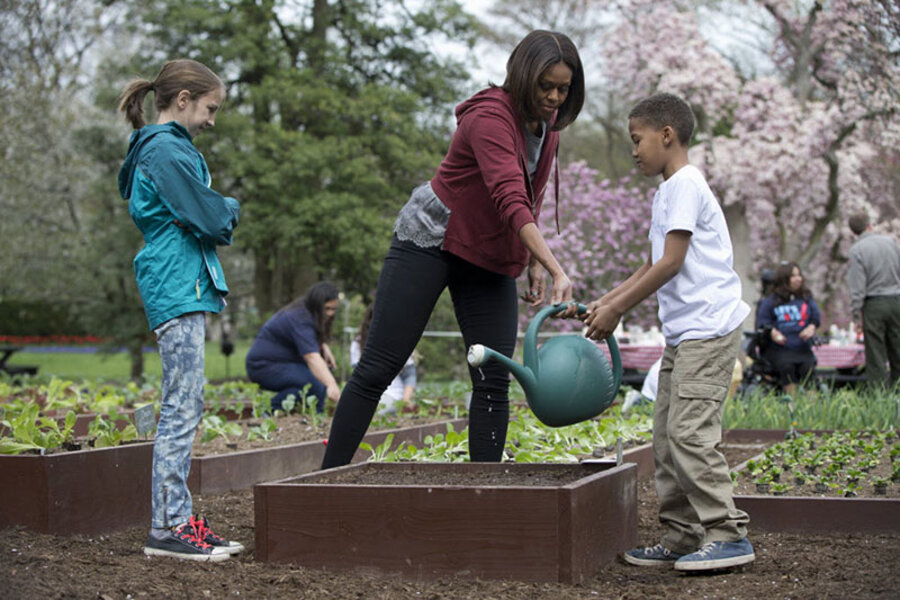School gardens help fruit, vegetables to flourish in low-income food deserts
Loading...
Green classrooms, incorporated into high school curricula, have sprouted nationwide to educate teenagers about nutrition and include them in community gardening.
Participating students invest their time and energy in providing their neighborhoods with ready access to healthy and affordable food. As a result, they may also improve academic performance and engagement at school and pass on their knowledge and habits to their families.
Roshawn Little, a rising junior at Eastern High School in Washington, D.C., has worked with City Blossoms, a non-profit that brings community gardens to schools, for three years, NPR reported. She is paid to work Tuesday through Saturday and is one of nearly a dozen students harvesting vegetables for the weekend’s farmers market, where teens sell the produce they make, NPR noted.
Little lives in an area defined as a "food desert" – a neighborhood that lacks access to healthy food, where junk-food restaurants typically outnumber grocery stores with fresh produce. According to the United States Department of Agriculture, about 23.5 million Americans live in food deserts.
"We're a chubby family and we love to eat. Well, I do," Little told NPR. "We mainly live around liquor stores and snack stores. There aren't that many grocery stores. They're way out and you have to drive so far. It seems so pointless, when there are snack stores right there.”
The initiative has affected more than just her own eating habits. According to NPR, Little said she brings produce home from the garden and her family now buys more fruits and vegetables.
NPR noted a similar initiative, called REAL School Gardens, has built nearly 100 gardens in Washington, D.C., Maryland, and Virginia, and trains teachers on how to incorporate the outdoors into their lessons. This could include “calculating the area of a plant bed” for math lessons or “learning the science of how plants grow.”
Jeanne McCarthy, executive director of the program, told NPR that partner schools have seen a 12-to-15 percent increase in the number of students passing standardized tests – not just those in the garden program, but school-wide.
Stephen Ritz, a teacher, pioneered the Green Bronx Machine, an indoor teaching garden system at PS 55, a high school in the South Bronx – a community known for issues related to hunger, homelessness, and obesity.
Ritz and his students have grown more than 30,000 pounds of produce in a vertical tower, which enables crop growth without soil, Take Part reported.
Ritz said in a TED Talk: since the program’s inception in 2009, which he refers to as “the new green graffiti”, daily attendance rates at school have soared from 40 percent to 93 percent and 2,200 youth jobs have been created.
“To think that food is the entry point for public education – for reading, for writing, for literacy, for math, for aspiration and inspiration – is incredible. But most importantly, by growing food we’re creating life,” Ritz said, according to TakePart.
Countless studies also suggest children are more likely to eat fruits and vegetables if they help garden them.
Ritz firmly believes schools are the perfect target for reforms aimed at eliminating food deserts – a target first lady Michelle Obama set to be completed by 2017 as part of her Let’s Move campaign to end childhood obesity nationwide.
“It’s easier to raise healthy children than fix broken men,” Ritz said, according to TakePart.
The first lady’s announcement of the goal in 2010 was followed by a $400 million investment from the government, which focuses on providing tax breaks to supermarkets that open in food deserts.
Steve Cummins, professor of population health at London School of Hygiene and Tropical Medicine told PBS there’s no doubt food deserts are a massive problem but there’s a dearth of information on the best solutions.
Cummins authored a study that analyzed a new supermarket in Philadelphia, which was funded by a statewide scheme for underserved communities.
His study suggested new shops may lack the familiarity, stock products that are too expensive, and “assault” the senses, making it easy to over-shop, according to PBS.
Cummins also found initiatives that just introduce supermarkets are not enough – because they don’t address the fundamental behavioral change that need to accompany an increase in access. However, he acknowledged the access they provided was essential.
Cummins told PBS: “If you think about Kevin Costner in the Field of Dreams – ‘If you build it, they will come’ – I guess that’s the kind of logic model that underpins these interventions. But that doesn’t do everything it’s supposed to do."
This critique would suggest the green classroom solution could be an innovative solution that addresses the cultural shift needed to eliminate food deserts.







